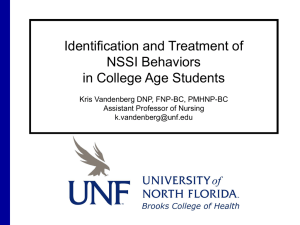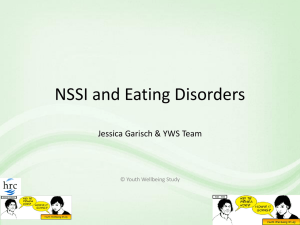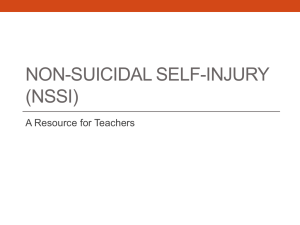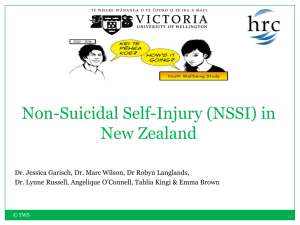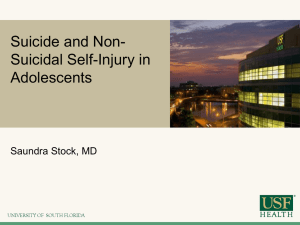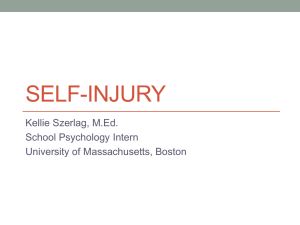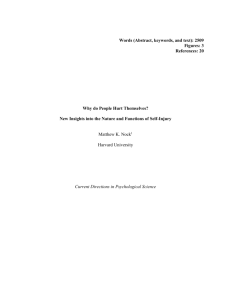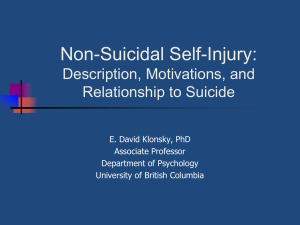Real-Time Measurement of Self-Injurious Thoughts and Behaviors
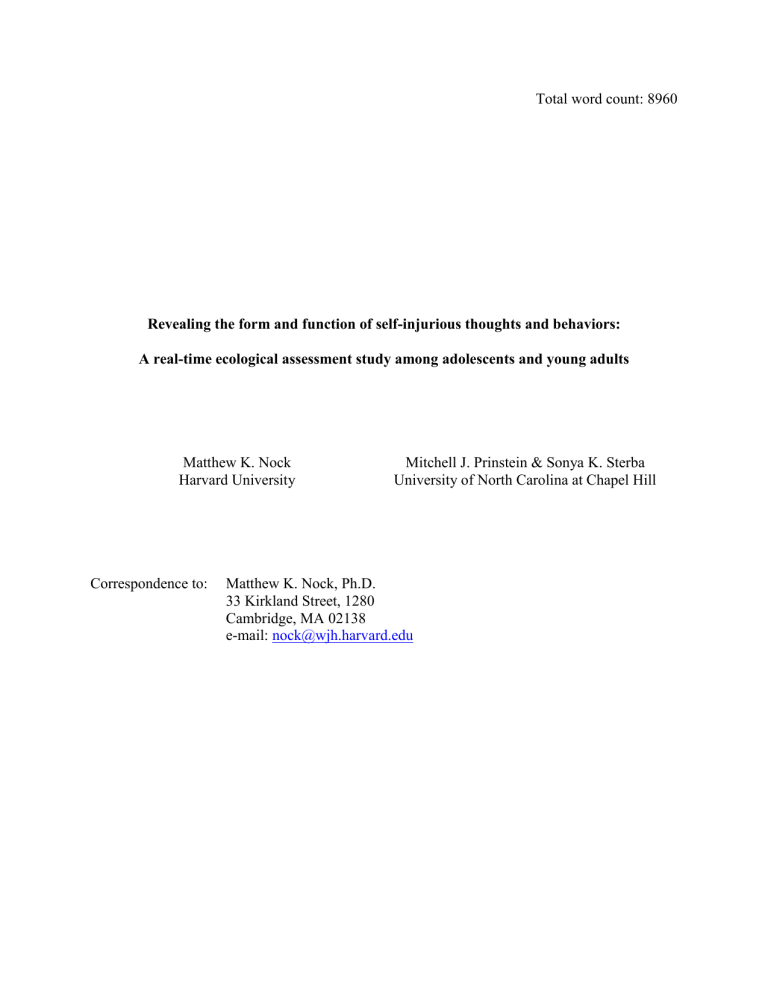
Total word count: 8960
Revealing the form and function of self-injurious thoughts and behaviors:
A real-time ecological assessment study among adolescents and young adults
Matthew K. Nock
Harvard University
Mitchell J. Prinstein & Sonya K. Sterba
University of North Carolina at Chapel Hill
Correspondence to: Matthew K. Nock, Ph.D.
33 Kirkland Street, 1280
Cambridge, MA 02138 e-mail: nock@wjh.harvard.edu
Form and function of self-injury 2
Abstract
Self-injurious behaviors are among the leading causes of death worldwide. However, the basic nature of self-injurious thoughts and behaviors (SITBs) is not well-understood because prior studies have relied on long-term, retrospective, aggregate, self-report assessment methods. We used ecological momentary assessment methods to measure suicidal and non-suicidal SITBs as they naturally occur in real-time. Participants were 30 adolescents and young adults with a recent history of self-injury who completed signal- and event-contingent assessments on handheld computers over a 14-day period, resulting in the collection of data on 1262 thought and behavior episodes. Participants reported an average of 5.0 thoughts of nonsuicidal self-injury
(NSSI) per week, most often of moderate intensity and short duration (1-30 minutes), and 1.6 episodes of NSSI per week. Suicidal thoughts occurred less frequently (1.1 per week), were of longer duration, and led to self-injurious behavior (i.e., suicide attempts) less often. Details are reported about the contexts in which SITBs most often occur (e.g., what participants were doing, who they were with, and what they were feeling before and after each episode). This study provides a first glimpse of how SITBs are experienced in everyday life and has significant implications for scientific and clinical work on self-injurious behaviors.
Form and function of self-injury 3
Self-injurious behaviors are among the leading causes of death and injury worldwide
(Nock, Borges et al., 2008; WHO, 2008), and represent one of the most perplexing problems facing psychological scientists. Philosophers have speculated about the nature of suicidal selfinjury for centuries (e.g., Kant, Camus, Rousseau, Satre, Hobbes, Locke, Hume)(see Minois,
1999), and over the past 50 years scientists have used systematic research methods to study selfinjurious thoughts and behaviors (SITBs). SITBs include both suicidal behaviors (e.g., suicidal thoughts, suicide attempts) as well as non-suicidal self-injury (NSSI), which refers to the direct, deliberate destruction of body tissue in the absence of lethal intent (Nock & Favazza, 2009;
Nock, Wedig, Janis, & Deliberto, 2008). This research has provided valuable information about the prevalence, risk factors, and treatment of these distinct but related forms of SITBs (Hawton
& van Heeringen, 2000; Nock, 2009b).
Despite recent advances in the assessment and treatment of SITBs (Brown et al., 2005;
Linehan et al., 2006), some of the most fundamental aspects of these outcomes remain poorly understood, and as a result SITBs remain very difficult to predict and prevent (Joiner et al., 2005;
Nock, Borges et al., 2008; Prinstein et al., 2008). Two aspects of the way SITBs have been studied have contributed to this state of affairs. First, researchers historically have favored a deductive approach in which general theories as to why people hurt themselves are generated and tested empirically, rather than using field observation and description to understand the form
(i.e., topographical characteristics) and function of the phenomena of interest. This limitation is not specific to the study of SITBs, but is true of psychological science more generally. As cogently argued several decades ago by Nobel laureate Niko Tinbergen (1963): “in its haste to step into the twentieth century and to become a respectable science, Psychology skipped the preliminary descriptive stage that other natural sciences had gone through, and so was soon
Form and function of self-injury 4 losing touch with the natural phenomena” (p. 411). This focus has remained over time, as recently noted by Kagan (2007): “psychologists begin their inquiries with a favored construct…and invent laboratory procedures that promise to reveal its referents rather than begin with a reliable phenomenon and explore its causes and properties. Most natural scientists begin with a puzzling, but robust, phenomenon that colleagues acknowledge as important…and probe its properties” (p. 372).
Second, psychological scientists have lacked the methods needed to measure SITBs as they naturally occur. SITBs appear to be transient phenomena that rarely occur during laboratory- or clinic-based assessments and so prior studies, including our own, have relied on the use of long-term, retrospective, aggregate self-report questions to measure SITBs (e.g., “How many times in your life have you thought about hurting yourself?”)(e.g., Nock, Holmberg,
Photos, & Michel, 2007). The methodological limitations introduced by relying on such a strategy are well-known (Bradburn, Rips, & Shevell, 1987; Schacter, 1999).
As a result of these limitations, basic information about SITBs as they naturally occur is lacking. For instance, perhaps surprisingly, among those at risk for SITBs no data exist regarding the actual frequency, intensity, or duration of self-injurious thoughts. Additionally, although some of the distal risk factors for SITBs are well-known (e.g., female sex, depression, borderline personality disorder)(Jacobson & Gould, 2007; Nock, Borges et al., 2008), very little is known about the proximal triggers for self-injurious thoughts, about what factors predict the transition from self-injurious thoughts to self-injurious behaviors, or about why people engage in
SITBs. Moreover, although most researchers and clinicians distinguish between self-injury that is suicidal versus non-suicidal in nature based on the reported intent of the behavior, empirical data are lacking regarding the extent to which these distinct forms of SITB differ in their
Form and function of self-injury 5 expression. Evidence showing that these putatively different forms of SITBs differ in their frequency, severity, duration, and common precipitants would strengthen the case for distinguishing between them (i.e., rather than lumping them into one category of “parasuicide” or
“deliberate self-harm” as is sometimes done in the literature). The answers to these fundamental questions would significantly advance our understanding of SITBs and would open up many new directions for scientific and clinical work.
Recent advances in the development of ecological momentary assessment (EMA) methods have provided novel ways of measuring behaviors and psychological processes as they occur outside the laboratory or clinic (Shiffman, Stone, & Hufford, 2008). The use of computerized assessment methods have proven especially useful in obtaining information about sensitive topics (Tourangeau & Yan, 2007; Turner et al., 1998). These new methods are ideally suited to measure SITBs as they occur in real time. Although still relying on self-report, the strengths of these methods include reduction of recall biases, increased reliability due to repeated assessment, and enhanced ecological validity due to data collection in natural settings (Hufford,
2007).
The purpose of the current study was to examine the real-time occurrence of SITBs among adolescents and young adults using EMA methods. We focused on adolescents and young adults in this study because SITBs are especially prevalent during this developmental period. Recent surveillance data reveal that suicide is the third leading cause of death among adolescents and young adults, and each year approximately 19% engage in NSSI, 13% seriously consider suicide, and 6% attempt suicide (Centers for Disease Control and Prevention, 2008;
Massachusetts Department of Education, 2006). We focused on SITBs among those with a recent history of NSSI because we were interested in this dangerous and perplexing clinical
Form and function of self-injury 6 behavior in itself, and because adolescents who engage in NSSI are at significantly increased risk for suicidal thoughts and attempts (Nock, Joiner, Gordon, Lloyd-Richardson, & Prinstein, 2006;
Prinstein et al., 2008). The use of a sample at high risk for SITBs increases the odds of observing such events during the assessment period; however, it also introduces potential limitations in generalizing the results of this study to all people who experience SITBs. Hence our immediate goal is to characterize the real-time occurrence of SITBs among the clinicallyrelevant group believed to be at highest risk for these behaviors—who might be natural targets for future interventions.
With these objectives in mind, our study’s first goal was to examine the basic form of
SITBs, including their frequency, intensity, and duration. Our second goal was to elucidate the contexts in which self-injurious thoughts are most likely to occur. We wanted to answer the descriptive questions—when thoughts of self-injury occur: what are people typically doing, who are they with, and what are they feeling. Our third goal was to test which proximal factors predict the transition from self-injurious thoughts to self-injurious behaviors. That is, among episodes of self-injurious thoughts, what factors predict the occurrence of self-injurious behavior. This is an important question both scientifically and clinically as most known risk factors for self-injurious behaviors (e.g., presence of mental disorders) are actually of limited use in determining if and when a person is going to transition from self-injurious thought to behavior
(Nock, Borges et al., 2008). As such, we sought to test what topographical characteristics (e.g., greater intensity) and contextual features (e.g., specific affective states) of self-injurious thoughts predict engagement in self-injurious behavior. Because this is the first study to systematically examine the process through which self-injurious thoughts might lead to self-injurious behaviors, we tested each topographical and contextual factor examined as potential predictors of this
Form and function of self-injury 7 transition in order to generate hypotheses for future studies in this area.
Our fourth and final goal was to examine the self-reported functions served by selfinjurious behaviors (i.e., what purpose might such behaviors serve in everyday life?). Research on the functions of NSSI using long-term, retrospective self-reporting has revealed that people report engaging in this behavior in the service of: (a) intrapersonal-negative reinforcement (e.g., to decrease/distract from negative thoughts/feelings), (b) intrapersonal-positive reinforcement
(e.g., to generate feeling/sensation when experiencing numbness or anhedonia), (c) interpersonalnegative reinforcement (e.g., to escape from some undesirable social situation), or (d) interpersonal-positive reinforcement (e.g., to communicate with/seek help from others)(e.g.,
Nock, 2009a; Nock & Prinstein, 2004, 2005). Guided by this earlier work, we examined the extent to which adolescents and young adults endorsed each function for each episode of selfinjurious behavior.
Method
Participants
Participants were 30 adolescents and young adults (12-19 years, M =17.3, SD =1.9) selected from a larger, cross-sectional community study of NSSI (N=94; described in Nock &
Mendes, 2008) based on inclusion criteria of: (i) experiencing NSSI thoughts in the past two weeks, and (ii) having access to a computer. Logistic regression analyses indicated that participants included in the present longitudinal study did not differ from the parent sample on sex, race, age, history of the 20 DSM-IV diagnoses assessed, or mode of recruitment, but only differed based on having been more likely to have experienced NSSI thoughts in the past month
(B=-.22, SE=.11, p= .048). The current sample was 86.7% female; 86.7% European American,
6.7% Hispanic, and 6.7% other race/ethnicities. Consistent with the characteristics of our
Form and function of self-injury 8 sample, several large studies of NSSI among adolescents and young adults suggest that those who engage in NSSI are mostly female, European American, and meet criteria for a wide range of psychiatric disorders, such as those reported in Table 1 (Jacobson & Gould, 2007). However, other studies have reported equal rates across sexes and race/ethnicities and there currently are no nationally representative data available regarding the demographic and psychiatric characteristics of those who engage in NSSI (Jacobson & Gould, 2007). As such, this sample cannot be considered representative of all adolescents and young adults who engage in NSSI or other SITBs.
Procedures
Participants, and their parents for those <18 years, provided informed consent to participate and were trained in the use of the personal digital assistants (PDAs) during a brief laboratory session. Participation involved carrying the PDA for 14 days and responding to a systematic series of questions several times per day using a stylus interface. A 14-day assessment period was chosen in an attempt to balance collecting enough data to capture multiple episodes of SITBs for each participant with the fact that EMA compliance decreases substantially after 1-2 weeks of assessments (Broderick, Schwartz, Shiffman, Hufford, & Stone,
2003). The PDAs were programmed to beep twice daily (at mid-day and end-of-day) signaling the participant to complete an entry (i.e., signal-contingent responding). In addition, participants were instructed to self-initiate an entry whenever they experienced a self-destructive thought or behavior (i.e., event-contingent responding). We examine later whether key findings are sensitive to event versus signal response elicitation. In several cases participants were not able to return to the lab immediately after the 14-day period (e.g., those who lived further distances from the lab) and so continued to make entries until they returned. Overall, participants made entries
Form and function of self-injury 9 on an average of 17.2 days ( SD =5.3). Participants were instructed to upload data to a secure server each evening, and data were checked each morning by research staff for the purpose of ongoing risk assessment and compliance monitoring. Participants were contacted via telephone for a risk assessment when responses suggested imminent risk of serious injury or if they failed to upload data for three consecutive days. They returned to the laboratory for a debriefing session after the data collection period and were paid $100 or were allowed to instead keep the
PDA ($135 value) if their compliance with the twice-daily signal-contingent entries exceeded
80%.
Assessment
Self-injurious thoughts and behaviors.
Participants’ past history of SITBs was assessed using the Self-Injurious Thoughts and Behaviors Interview (SITBI; Nock et al., 2007), a structured interview that assesses the presence, frequency (number of episodes), and severity of a range of SITBs including NSSI, suicide ideation, and suicide attempts. The SITBI has been shown to have strong inter-rater reliability (average κ=.99), test-retest reliability across 6 months
(average κ=.70), and convergent validity with respect to other measures of suicide ideation
(average κ=.54) and suicide attempt (κ=.65)(Nock et al., 2007). The presence and frequency of participants’ SITBs prior to EMA assessment according to the SITBI are presented in Table 1.
Psychiatric diagnoses. Participants’ current psychiatric diagnoses were assessed during their baseline laboratory visit using the Schedule for Affective Disorders and Schizophrenia for
School-Aged Children (K-SADS-PL; Kaufman, Birmaher, Brent, Rao, & Ryan, 1997). This semi-structured diagnostic interview was administered by the first author and four graduate research assistants who were trained to reliability and supervised throughout the course of the study (average reliability κ=.93 across all diagnoses). Diagnostic characteristics of the sample
Form and function of self-injury 10 are presented in Table 1.
Ecological momentary assessment. Participants responded to a brief (approximately 1-4 minutes) structured series of multiple-choice questions at each data-entry period about the form and functions of SITBs. Items were selected for inclusion in order to address each of the study goals. Response options (e.g., list of feelings that typically precede self-injury) were generated by drawing on prior studies using EMA methods, prior research on SITBs, and the clinical experience of the authors in working with self-injurious adolescents (see Online Supplement for a list of the specific items, response options, skip logic details, and information about hardware and software used). For both signal- and event-contingent entries, participants first were asked if they had experienced a thought of engaging in any self-destructive behavior (currently or since the last assessment), including: suicide attempt [defined in a brief manual given to each participant as “harming yourself with the intention of dying”] or NSSI [“harming yourself without wanting to die”], as well as alcohol use, substance use, bingeing, purging, unsafe sex, impulsive spending, or any other self-destructive behavior (each coded no/yes). We asked about this range of behaviors to examine the extent to which different self-destructive behaviors may co-occur and show similarities in form and function. If any self-destructive thought was reported, participants were asked follow-up questions regarding the characteristics of the thought, including the intensity (“Rate how intense the urge was to do the self-injurious/selfdestructive behavior” on a 5-point-scale from “not present” to “very severe”), duration (“Indicate how long you thought about doing the behavior you selected above” on a 6-point-scale from “<5 seconds” to “5-hrs to 1-day”), and the context in which it occurred (e.g., “who were you with?,”
“what were you doing?”). Respondents could check multiple responses for most items (e.g., if they engaged in more than one behavior, if they were with more than one person at the time of
Form and function of self-injury 11 their thought/behavior) and an “other” response was included to allow for the reporting of contextual factors that we did not query. If “other” was selected, participants were asked to specify in their own words what “other” signified. Participants who reported a self-destructive thought were then asked if they had engaged in that behavior. If so, they were asked follow-up multiple-choice questions regarding the intended function of the behavior (“Indicate why you did the behavior:” [a] “Rid of thought/feeling,” [b] “Feel something,” [c] “To communicate,” [d]
“Escape task/people,” [e] “Other”)(Nock & Prinstein, 2004), the actual consequences experienced (e.g., “Indicate what you felt when you hurt yourself”), and the duration of the behavior. If not, they were asked what they did instead of engaging in the behavior (“Identify the activities you did instead of hurting yourself”). This was asked in order to obtain information about adolescents’ alternative coping behaviors that may be useful for guiding treatment development.
Data Analysis
Data were analyzed using two strategies. First, descriptive statistics were calculated to examine the frequency, intensity, duration, co-occurrence, antecedents, and consequences of
SITBs. Second, generalized hierarchical linear modeling (HLM) was used to test which contextual features of self-injurious thoughts predicted NSSI thoughts that did (=1) vs. did not
(=0) lead to NSSI behaviors (i.e., among episodes of self-injurious thoughts, what factors predict the occurrence of self-injurious behaviors?) while accounting for the nestedness of observations within days within individuals. M plus 5.1 software with full-information robust maximum likelihood estimation was used for these analyses; main findings were replicated in SAS,
NLMIXED, and GLIMMIX.
Results
Form and function of self-injury 12
Preliminary Analyses
All participants completed the study and 83.3% were fully compliant in that they completed at least the 28 entries requested. There were 1227 entries ( M =40.9 per person;
SD =21.2; range=5-108) that described 1262 episodes of self-destructive thoughts and behaviors
(i.e., some entries reported multiple thoughts/behaviors while others reported no thoughts/behaviors). Of all reported episodes, 344 were instances of NSSI thoughts, 104 were episodes of NSSI behavior, 26 were suicidal thoughts, and none were actual suicide attempts.
Subsequent analyses focus primarily on these 474 SITBs.
Participants who reported experiencing NSSI thoughts during the study period (93.3%) reported an average of 5.0 NSSI thoughts per week ( SD =3.4). NSSI was performed by 86.7% of participants, who reported an average of 1.6 of NSSI episodes per week ( SD =1.1). Participants who experienced suicidal thoughts during the study period (33.3%) had an average of 1.1 suicidal thoughts per week ( SD =0.6).
HLM Model-Building Procedures
Before describing the results of our HLM analyses predicting when NSSI behaviors accompany NSSI thoughts, we first describe the procedures followed to construct these models.
Choice of appropriate nesting structure. In order to pick an appropriate nesting structure, we began with an unconditional model and compared a two-level random intercept only model
(Model 1) versus a three-level random intercept only model (Model 2) (i.e., is there significant unexplained variability in level of NSSI behavior across observations-within-individual ( k )
[Model 1] or across days-within-individual and observations-within-day [Model 2]) Subscript i denotes observation; j denotes day; k denotes individual.
Model 1:
Form and function of self-injury 13
Response distribution: nssi ik
|
ik
~ BER (
ik
)
Link function:
ik
log it(
ik
)
Linear predictor: level 1 (observation): level 2 (individual):
0 ik k
0
00 k u
0 k
~ N u
0
k
Model 2:
Response distribution: nssi ijk
|
ijk
~ BER (
ijk
)
Link function:
ijk
log it(
ijk
)
Linear predictor: level 1 (observation): level 2 (day): level 3 (indivi dual):
ijk
0
00 jk k
0 jk
00
000 k
u u
00
0 k jk u
0 jk u
00 k
~ N
(2)
0
, 00
0 0
(3)
00
In Models 1 and 2, as well as all subsequent models, the response distribution for the binary outcome (hereafter labeled nssi ) was Bernoulli, and a logit link was used to relate the predictors of nssi to the expected value of nssi (
) in order to ensure model-predicted nssi could not fall outside the range of 0-1. In Model 1, the intercept coefficient is
, with mean
0 k
and
00 variance
(2)
00 of the individual-level deviations from the mean u . In Model 2, the intercept
0 k coefficient is
0 jk
, with mean
000
, and variance
(2)
00
of the day-level deviations from the mean u
0 jk
, and variance
(3)
00 of the individual-level deviations from the mean, u . Predictors are
00 k reported on the logit scale. The residual variance (not shown) is fixed to
/ 3 .
In Model 1, the mean intercept was significantly different than zero (
00
=-2.602,
SE=.187, p< .001) and the variance of the intercept across individuals was also significantly different than zero (
(2)
=.69, SE=.22, p= .002). The proportion of between-individual to
00
Form and function of self-injury 14 between- plus within-individual variance in nssi was ICC individual_level
=.40. In Model 2, the variance of the intercept across days
(3)
00 could not be estimated, indicating that the ICC day_level would be extremely small and can be ignored. Therefore, two levels (observations within individual) were found to be an adequate nesting structure.
Choice of appropriate functional form of change over time. When using HLM to analyze
EMA data, recommended practice (West & Hepworth, 1991) is to: (i) check for seriality (e.g. autocorrelation, given that observations are so close together in time), while controlling for the fact that lags between observations are unequal in our study (Beal & Weiss, 2003), (ii) check for cyclicity (e.g. if behaviors were more likely on weekend than weekday), and (iii) check for trend
(i.e., included a time-within-day predictor which we coded on a proportion of the day metric [0 to 1]). Hence, in Model 3 we kept the same response distribution and link function but added fixed level 1 slopes for lagged NSSI behavior ( nssilag ) and amount of time since last observation
( lag ) and an interaction of these terms ( lag×nssilag
)—to check for seriality.
Model 3: level 1 (observation): level 2 (individual):
0
2 ik
1 k
3 k k k
0
00
10
20
30 k
u
0
1 k k nssilag ik
2 k lag ik
3 k
ik u
0 k
~ N
All were nonsignificant: level 1 slope of nssilag (
=-.74, SE=.68, p= .275), level 1 slope of lag
10
(
20
=.42, SE=.26, p=.
112), level 1 slope of nssilag×lag (
30
=.03, SE=1.07, p= .381). We did graphical plots of model-implied nssi to check for cyclicity; none was found. In Model 4 we added time-within-day as a predictor, allowing the trend effect to have a fixed component as well as across-individual variability.
Form and function of self-injury 15
Model 4: level 1 (observation): level 2 (individual):
0
1 k
2 ik k k
3
4 k k
0 k
00
10
20
30
40 u
0
1 k k u
1 k nssilag ik
2 k lag ik
3 k ik
4 k timewithinday ik u
0 k ~ u
1 k
N
0
0
,
(2)
00
(2)
10
(2)
11
Mean slope of time-within-day (
40
=.70, SE=2.42, p=.
772), individual-variability in the slope of time-within-day (
(2)
=2.76, SE=19.35, p= .887), and covariance of individual intercepts and
11 time-within-day slopes (
(2)
10
=-.20, SE=13.61, p=.
884) were all nonsignificant. Hence, a random intercept only model was found to be an adequate functional form for these data.
Evaluation of conditional models. In the next phase of model-building, level 1 and level
2 predictors were added to the unconditional model with our chosen nesting structure and functional form of change over time (i.e. to the two-level random intercept only model). The effects of 43 level 1 predictors of NSSI behavior and two level 2 predictors of NSSI behavior
(age, gender) were of interest, but could not all be included simultaneously. Therefore six separate conditional models were estimated (Models 5-10), each containing a separate subset of level 1 predictors. To minimize risk of omitted variable bias, subsets of predictors were chosen that were theoretically related and that had the same question stem, such that they were expected to be more correlated within-subset than across-subset. Although this approach did not entail any stepwise procedures involving pruning nonsignificant predictors, it should nonetheless still be viewed as exploratory, particularly given that no adjustments were made to control type I error. None of the level 1 predictors were hypothesized to have random slopes; fixed slopes were estimated for each. Since the equations for Models 5-10 were very similar, only differing
Form and function of self-injury 16 in the particular set of level 1 predictors included, only one equation (Model 6) is provided here.
Model 6. level 1 (observation): ik level 2 (individual):
0 k
0 k 1 k purgetht ik
01 ag e k drugtht ik
5 k
02
1 k
2
3
4
5
6
7 k k k k k k
4 k
00
10
20
30
40
50
60
70
sex k
alctht
2 k sextht ik u
0
k
ik
6 k
3 k bingetht spendtht ik
ik
7 k suictht ik u
0 k
~ N
In subsequent sections, the results from these final HLM Models 5-10 are described following basic descriptive statistics about each set of predictors. Tables 3-5 present both descriptive statistics and HLM results for a given set of predictors, and Tables 2 and 6 present additional descriptive analyses.
Form of SITBs
Intensity and duration of self-injurious thoughts . Descriptive analyses indicated that
NSSI thoughts most often were of moderate-to-severe intensity, while suicidal thoughts typically were mild-to-moderate when present (Table 2). The duration of NSSI thoughts was normally distributed, while suicidal thoughts tended to be longer in duration (Table 2). HLM analyses for
Model 5 revealed that when NSSI thoughts were present, the occurrence of NSSI behavior was predicted by greater thought intensity (
=2.06, se (
)=.39, p <.0001; odds ratio=7.85). In other words, there was a 7.85-fold increase in the odds of NSSI with each one-unit increase in thought intensity on the 0-4 scale shown in Table 2. The occurrence of NSSI behavior also was associated with a shorter duration of NSSI thoughts (
= -.68, se (
)=.22, p <.01, OR=0.51). Sex and age did not emerge as significant predictors in these analyses.
Form and function of self-injury 17
Overlap of Self-Destructive Thoughts
We examined the proportion of the time that thoughts of NSSI and suicide were accompanied by simultaneous thoughts of engaging in other forms of self-destructive behaviors.
The rate of overlap with these other thoughts is presented in Table 3. These descriptive analyses showed that thoughts of both suicide and NSSI co-occurred with thoughts of alcohol and drug use 13.5%-34.6% of the time. Interestingly, NSSI thoughts were accompanied by thoughts of suicide only 1.0%-4.2% of the time, highlighting the distinction between these two behaviors.
Suicidal thoughts were accompanied by NSSI thoughts 42.3% of the time, which is likely a function of both the greater frequency of NSSI thoughts and of the nature of the sample selected for this study (i.e., adolescents with a recent history of NSSI). HLM analyses (Table 3, Model 6) revealed no significant effects of these co-occurring self-destructive thoughts on the propensity for NSSI behaviors.
Contextual Features
Descriptive analyses indicated that when thoughts of both suicide and NSSI began, adolescents were most often socializing, resting, or listening to music (Table 4). They were using drugs or alcohol during only 0.0%-4.8% of episodes of self-injurious thoughts. Thus, although prior research suggests that suicide and NSSI are more prevalent among those with alcohol and substance use disorders, the vast majority of episodes of self-injurious thoughts occur while adolescents are sober. HLM analyses (Table 4, Model 7) revealed no significant effects for any of these activities as predictors of the propensity for NSSI behaviors. Further descriptive analyses indicated that adolescents most often were alone when they experienced the onset of self-injurious thoughts (Table 4). They also experienced such thoughts while with peers and friends a substantial portion of the time, and less often when with family or strangers. HLM
Form and function of self-injury 18 analyses (Table 4, Model 8) revealed that among episodes of NSSI thoughts, being alone was a significant predictor of engagement in NSSI.
Additional descriptive analyses indicated that thoughts of NSSI were preceded most often by worry, followed by having a bad memory or feeling pressure (Table 5). These same precipitants were reported by adolescents as the most common triggers for thoughts of suicide, along with having an argument with someone. Adolescents reported having thoughts of suicide or NSSI after being encouraged by others to engage in the behaviors 1.7%-3.8% of the time.
This was the least often endorsed precipitant, but one that raises some concern. HLM analyses revealed that none of these factors predicted propensity for NSSI behaviors in the context of
NSSI thoughts (Table 5, Model 9).
Descriptive analyses indicated that NSSI thoughts occurred most often in the context of feeling sad/worthless, overwhelmed, or scared/anxious (Table 5). Interestingly, however, HLM analyses indicated that feeling scared/anxious or overwhelmed did not predict the occurrence of
NSSI behavior. Instead, the odds of engaging in NSSI were significantly increased in the presence of feeling rejected, anger toward oneself, self-hatred, numb/nothing, and anger towards another, but decreased in the presence of feeling sad/worthless (Table 5, Model 10). Additional descriptive analyses indicated that suicidal thoughts occurred in the context of a wide range of negative affective states. Overall, there was general consistency in the order in which negative affective states were endorsed for both thoughts of NSSI and suicide; however, the rate of endorsement was consistently higher for suicidal thoughts, suggesting that such thoughts are preceded by more negative affect.
Function of NSSI
In the 104 episodes of NSSI recorded, participants were asked about why they had just
Form and function of self-injury 19 engaged in NSSI. Descriptive analyses showed that adolescents reported most often engaging in
NSSI for the purposes of intrapersonal-negative reinforcement (64.7% of episodes), followed by intrapersonal-positive (24.5%), and much less often for the purposes of interpersonal-negative
(14.7%) and interpersonal-positive (3.9%) reinforcement. In order to better understand what affective or cognitive state adolescents were attempting to escape via intrapersonal negative reinforcement, we asked a follow-up question about this whenever that function was endorsed.
Interestingly, adolescents reported not only attempting to use NSSI to escape from aversive affective states such as anxiety (34.8% of episodes), sadness (24.2%), and anger (19.7%), but also from aversive cognitive states, such as a bad thought (28.8%) or bad memory (13.6%).
Alternative Behaviors
When adolescents had a thought of NSSI but did not engage in this behavior, they recorded what behavior they performed instead. The descriptive statistics in Table 6 show that instead of engaging in NSSI when they had a thought to do so, adolescents most often reported trying to change their thoughts (22.3% of the time), talking to someone, or engaging in a range of potentially distracting behaviors such as going out, doing homework, or using the computer.
Similarly, following suicidal thoughts, instead of making a suicide attempt adolescents most often talked to someone, tried to change their thoughts, or did work/homework.
Sensitivity Analyses
In this study, individuals completed assessments that were both signal-contingent and event-contingent. This means that there is a potential dependency between the mechanism by which responses were solicited (selection mechanism) and the psychological mechanism that generates the clinical outcome (outcome-generating mechanism), and this dependency could result in selection bias for HLM parameters of interest (e.g., level 1 fixed slopes). To investigate
Form and function of self-injury 20 this possibility, we expanded HLM Models 5-10 into shared parameter models (e.g., Follmann
& Wu, 1995). That is, we (i) specified a selection model and (ii) tested whether the selection model was independent from each of the outcome Models 5-10. Specifically, for (i) our selection model stipulated that persons would be more likely to self-initiate a response when they were more sad, less numb, more rejected, and not with peers, controlling for age and sex. For
(ii) we allowed a dependency between the selection model and each outcome Model 5-10 by permitting the random effect for the selection model to covary with the random effect for that particular outcome model (labeled
o,s
, below). In so doing, we account for a “non-ignorable” or
“not missing at random” selection process in which individuals farther from the grand mean on
NSSI behavior are allowed to have a higher probability of selecting into the sample. As an example, the shared parameter version of Model 6 is shown below; outcome model parameters are denoted with o superscripts and selection model parameters are denoted with s superscripts.
Outcome submodel (predicting nssi behavior): reduced form:
o ik
o o
00
60
o
10 drugtht spendtht ik
ik o
70
o
20 alctht ik suictht ik
o
01
o
30 ag e k bingetht ik
o
02 sex k
u o
40 o
0 k purgetht ik
o
50 sextht ik
Selection submodel (predicting self-initiated vs. signal-initiated response): reduced form:
s ik
+ u u o
0 s
0 k k
~ s
40 s
00
N
0
0
s
10 reject ik withpeer
,
ik o o,s
s
01 s
s
20 ag e k
sad
ik s
02
sex s
30 k numb ik
u s
0 k
Results of fitting shared-parameter versions of each Models 5-10 indicated that our hypotheses about the selection mechanism were partially supported: individuals were more likely to self-initiate a response when they perceived greater rejection ( p<.
01) and were not with peers
( p< .05), controlling for sadness, numbness, age, and sex. However, there was fortunately not statistically significant dependency between the selection mechanism and outcome-generating mechanism: individual deviations in self-selected responding were not significantly related to
Form and function of self-injury 21 individual deviations in NSSI behaviors (i.e.
o,s always p> .05). Consequently, the same overall pattern of significant and nonsignificant fixed effects and variance components emerged in the shared parameter models as did in the original HLM Models 5-10—except for binge thoughts, which significantly predicted NSSI only in a shared parameter model (est.=.92, SE=.46, p< .05).
This sensitivity analysis provides evidence that our results are robust to effects of this nonrandom selection of responses, assuming we properly specified our selection model and outcome models.
Discussion
Information about the fundamental characteristics of SITBs is vital to the understanding and scientific study of these dangerous behavior problems; however, such information has escaped empirical study due to the transient nature of these phenomena. This study used recent innovations in EMA methods to examine SITBs as they occur in everyday life. Several specific findings from this study warrant further elaboration.
At the most basic level, this study demonstrates the feasibility of using EMA methods with people experiencing SITBs. Prior studies have used diary methods to measure the daily experiences of healthy adults (e.g., Hankin, Fraley, & Abela, 2005) and people who engage in common health risk behaviors such as cigarette smoking (e.g., Shiffman & Paty, 2006). This study extends recent research on the use of EMA methods to better understand more sensitive and clinically severe behaviors (e.g., Trull et al., 2008).
This study also provides previously unavailable information about how SITBs are experienced in real-time. The self-injurers included in this study reported approximately one thought of NSSI per day, most often of moderate intensity and short duration (1-30 minutes) and two episodes of NSSI per week. Compared to NSSI thoughts, suicidal thoughts occurred less
Form and function of self-injury 22 frequently, were of longer duration, and led to self-injurious behavior (i.e., suicide attempts) less often. Interestingly, thoughts of NSSI rarely were accompanied by suicidal thoughts— highlighting the distinction between these different forms of SITB—but co-occurred with thoughts of alcohol/drug use and bingeing/purging approximately 15-20% of the time. This suggests that people who engage in multiple clinical behaviors (i.e., comorbidity) may simultaneously consider engaging in different pathological behaviors before selecting one within a given episode. This provides new insight into the nature of comorbid psychopathology.
Notably, although participants thought of using alcohol/drugs during approximately 15-20% of their self-injurious thoughts, they reported actually doing so during approximately 3-5% of NSSI thoughts, suggesting NSSI occurs primarily while sober. However, these may be slight underestimates, as it is possible that participants were less likely to complete PDA entries while using alcohol/drugs.
Understanding what factors predict the transition from self-injurious thoughts to selfinjurious behaviors has been one of the most challenging aspects of scientific and clinical work on SITBs. The EMA methods used in this study provided a unique opportunity to closely examine factors that might predict instances in which self-injurious thoughts lead to selfinjurious behaviors. Results revealed that the occurrence of NSSI is predicted by a greater intensity and shorter duration of NSSI thoughts. This latter finding may reflect the cessation of
NSSI thoughts following engagement in the behavior. Prior research suggests that a tendency to ruminate about negative events is associated with increased risk of engaging in SITB (Selby,
Anestis, & Joiner, 2007), and that people may use self-injurious behavior as an effective means of distracting oneself from aversive rumination (Najmi, Wegner, & Nock, 2007). Our findings complement this earlier work and add to a growing literature suggesting that self-injury
Form and function of self-injury 23 represents an effective method of ceasing rumination about negative events or self-injury itself.
One concerning finding was that in some cases, other people are encouraging youth to engage in NSSI. Particularly troublesome is that although this occurred in only a small number of instances, it was associated with nearly a doubling of the odds of engaging in NSSI (albeit not statistically significant). This finding is consistent with prior reports of the social contagion that can occur with NSSI (Prinstein, Guerry, Browne, & Rancourt, 2009), and suggests that in some instances peer influence can be explicit in nature. Future research is needed to further illuminate the mechanisms through which the behavior of one’s peers can influence the increase, as well as decrease, of NSSI and other health risk behaviors.
Regarding the affective states that preceded NSSI, it is interesting to note that although feelings such as numbness and rejection were present during only a minority of NSSI thoughts, their presence was associated with significantly greater odds of NSSI behavior. Gaining a better understanding of why some specific affective states (e.g., anger, self-hatred, rejection) predict engagement in NSSI represents a very important direction for future research. It may be that these states are characterized by higher arousal and that this elevated arousal is what increases the odds of engaging in NSSI (Nock & Mendes, 2008). The negative association between sadness and NSSI was surprising. Prior studies suggesting that negative/depressive affective states are associated with avoidance motivation, whereas states such as anger are associated with approach motivation, may help to explain this pattern of findings (Carver & Harmon-Jones,
2009). However, this interpretation is speculative and the picture is likely much more complex
(Watson, 2009). Future studies must carefully and more objectively assess real-time affective experiences before, during, and after SITBs in order to better understand how such states might influence the occurrence of such outcomes. Notably, we were unable to study the transition from
Form and function of self-injury 24 suicidal thoughts to attempts given the lack of suicide attempts during the study period and this remains an important research direction.
Our findings on the reported functions of NSSI are consistent with the retrospectively reported functions of this behavior (Klonsky, 2007) and extend earlier research in two important ways. First, our examination of individual episodes of NSSI provided a measure of the relative frequency of each function. Interestingly, NSSI was reportedly performed for intrapersonal reinforcement 85-90% of the time and for interpersonal reinforcement only 15-20% of the time.
Second, NSSI typically is conceptualized as serving an affect regulation function (Klonsky,
2007; Nock & Mendes, 2008), and our results suggest that NSSI frequently serves a cognitive regulation function as well by distracting from unwanted negative thoughts (Najmi et al., 2007).
Prior research on the proposed functions of NSSI has shown that individual difference factors can statistically predict engagement in NSSI in the service of intrapersonal vs. interpersonal functions. For instance, elevated physiological arousal in response to stress and the presence of prior attempts to escape distress (i.e., suicide attempts) are particularly associated with the intrapersonal function of NSSI, while the experience of social problems is predictive of the interpersonal functions of NSSI (Nock & Mendes, 2008; Nock & Prinstein, 2005). Future research that integrates these prior findings with the current results, such as by testing the extent to which intrapersonal vs. interpersonal precipitants can predict individual episodes of NSSI in real-time, will be especially useful in further enhancing our understanding of how, why, and among whom individual episodes of SITBs occur.
The ultimate goal of this line of research is the prevention of SITBs, and this study provides new information about what adolescents often do instead of acting on their selfinjurious thoughts. The alternative behaviors reported in this study focused largely on actively
Form and function of self-injury 25 engaging in activities (e.g., went out, did homework) or interactions (e.g., talked to someone), and less often on more passive behaviors like watching television or sleeping. These results suggest that these and other methods of behavioral activation might be usefully incorporated into interventions aimed at decreasing the occurrence of SITBs (e.g., Wallenstein & Nock, 2007).
Notably, however, it will be important to gather more specific data about the alternative behaviors used instead of self-injurious behaviors. For instance, although “went out” (reported above) appears to be a positive alternative to self-injurious behavior, we did not assess what participants did when they “went out,” and it is possible that this included activities such as alcohol/drug use. Future studies must further document and experimentally test these potential alternatives to engaging in self-injurious behavior.
Several important limitations of this study must be considered when interpreting the results. First, the sample was relatively small and not representative of the general population in that it included adolescents and young adults with a recent history of NSSI, was mostly female, and included only those willing to participate in a somewhat demanding research protocol.
These selection factors limit generalizations that can be made from these data to people in the general population who experience SITBs at some point in their life. As such, an important next step for future studies is to use EMA methods in a larger, more diverse sample (e.g., more males, older participants) in order to determine which findings generalize to self-injurers as a group, and which are specific to adolescents and young adults with a history of NSSI. Second, although the use of real-time data collection methods has been shown to decrease the influence of recall biases while increasing reliability and ecological validity (Hufford, 2007), it is important to bear in mind that these data are still based on self-report and so are subject to the well-known limitations associated with such data (Nisbett & Wilson, 1977; Takarangi, Garry, & Loftus,
Form and function of self-injury 26
2006). Concerns about the accuracy and validity of self-report are especially important when assessing cognitive and affective processes that may operate partly or wholly outside of conscious awareness. For instance, we relied on participants’ attributions about why they engaged in NSSI; however, it is important to note that some of the antecedent and consequent events maintaining the participants’ NSSI may very well occur outside their awareness. The recent development of performance-based methods of assessing self-injurious thoughts provide new opportunities for circumventing the use of self-report of such thoughts (Nock & Banaji,
2007), and future studies combining such methods with the use of EMA will enhance the understanding of how SITBs occur and change over time. Third, although we attempted to be comprehensive in the domains assessed, we were able to include only a limited range of constructs at each assessment period. SITBs are multi-determined behaviors and this study only scratched the surface of the many factors likely influencing them. Future studies should assess in real-time the broader range of psychological, interpersonal, and biological factors likely influencing the occurrence of these dangerous behaviors.
Form and function of self-injury 27
Acknowledgement
This research was supported by the American Foundation for Suicide Prevention. We are grateful to Elizabeth Holmberg, Christine Cha, and Halina Dour for their assistance with this project.
Form and function of self-injury 28
References
Beal, D. J., & Weiss, H. M. (2003). Methods of Ecological Momentary Assessment in
Organizational Research. Organizational Research Methods, 6 , 440-464.
Bradburn, N. M., Rips, L. J., & Shevell, S. K. (1987). Answering autobiographical questions:
The impact of memory and inference on surveys. Science, 236 (4798), 157-161.
Broderick, J. E., Schwartz, J. E., Shiffman, S., Hufford, M. R., & Stone, A. A. (2003). Signaling does not adequately improve diary compliance. Annals of Behavioral Medicine, 26 (2),
139-148.
Brown, G. K., Ten Have, T., Henriques, G. R., Xie, S. X., Hollander, J. E., & Beck, A. T. (2005).
Cognitive therapy for the prevention of suicide attempts: A randomized controlled trial.
Journal of the American Medical Association, 294 (5), 563-570.
Carver, C. S., & Harmon-Jones, E. (2009). Anger is an approach-related affect: Evidence and implications. Psychological Bulletin, 135 (2), 183-204.
Centers for Disease Control and Prevention. (2008). Youth Risk Behavior Surveillance- United
States, 2007. Morbidity and Mortality Weekly Reports, 57 (SS-4), 1-136.
Follmann, D., & Wu, M. (1995). An approximate generalized linear model with random effects for informative missing data. Biometrics, 51 (1), 151-168.
Hankin, B. L., Fraley, R. C., & Abela, J. R. (2005). Daily depression and cognitions about stress:
Evidence for a traitlike depressogenic cognitive style and the prediction of depressive symptoms in a prospective daily diary study. Journal of Personality and Social
Psychology, 88 (4), 673-685.
Hawton, K., & van Heeringen, K. (Eds.). (2000). The international handbook of suicide and attempted suicide . West Sussex, England: John Wiley & Sons.
Form and function of self-injury 29
Hufford, M. R. (2007). Special methodological challenges and opportunities in ecological momentary assessment. In A. A. Stone, S. Shiffman, A. A. Atienza & L. Nebeling (Eds.),
The science of real-time data capture: Self-reports in health research (pp. 54-75).
Jacobson, C. M., & Gould, M. (2007). The epidemiology and phenomenology of non-suicidal self-injurious behavior among adolescents: A critical review of the literature. Archives of
Suicide Research, 11 (2), 129-147.
Joiner, T. E., Conwell, Y., Fitzpatrick, K. K., Witte, T. K., Schmidt, N. B., Berlim, M. T., et al.
(2005). Four studies on how past and current suicidality relate even when "everything but the kitchen sink" is covaried. Journal of Abnormal Psychology, 114 (2), 291-303.
Kagan, J. (2007). A trio of concerns. Perspectives on Psychological Science, 2 (4), 361-376.
Kaufman, J., Birmaher, B., Brent, D. A., Rao, U., & Ryan, N. D. (1997). Schedule for Affective
Disorders and Schizophrenia for School Age Children, Present and Lifetime Version (K-
SADS-PL): Initial reliability and validity data. Journal of the American Academy of
Child and Adolescent Psychiatry, 36 , 980-988.
Klonsky, E. D. (2007). The functions of deliberate self-injury: A review of the evidence. Clinical
Psychology Review, 27 (2), 226-239.
Linehan, M. M., Comtois, K. A., Murray, A. M., Brown, M. Z., Gallop, R. J., Heard, H. L., et al.
(2006). Two-year randomized controlled trial and follow-up of dialectical behavior therapy vs therapy by experts for suicidal behaviors and borderline personality disorder.
Archives of General Psychiatry, 63 (7), 757-766.
Massachusetts Department of Education. (2006). 2005 Massachusetts Youth Risk Behavior
Survey . Malden, MA: Massachusetts Department of Education.
Minois, G. (1999). History of suicide: Voluntary death in Western culture (L. G. Cochrane,
Form and function of self-injury 30
Trans.) . Baltimore, MD: Johns Hopkins University Press.
Najmi, S., Wegner, D. M., & Nock, M. K. (2007). Thought suppression and self-injurious thoughts and behaviors. Behaviour Research and Therapy, 45 , 1957-1965.
Nisbett, R. E., & Wilson, T. D. (1977). Telling more than we can know: Verbal reports on mental processes. Psychological Review, 84 (3), 231-259.
Nock, M. K. (2009a). Why do people hurt themselves? New insights into the nature and function of self-injury. Current Directions in Psychological Science, 18 (2), 78-83.
Nock, M. K. (Ed.). (2009b). Understanding non-suicidal self-injury: Origins, assessment, and treatment . Washington, D.C.: American Psychological Association.
Nock, M. K., & Banaji, M. R. (2007). Prediction of suicide ideation and attempts among adolescents using a brief performance-based test. Journal of Consulting and Clinical
Psychology, 75 (5), 707-715.
Nock, M. K., Borges, G., Bromet, E. J., Cha, C. B., Kessler, R. C., & Lee, S. (2008). Suicide and suicidal behaviors. Epidemiologic Reviews, 30 (1), 133-154.
Nock, M. K., & Favazza, A. (2009). Non-suicidal self-injury: Definition and classification. In M.
K. Nock (Ed.), Understanding non-suicidal self-injury: Origins, assessment, and treatment (pp. 9-18). Washington, DC: American Psychological Association.
Nock, M. K., Holmberg, E. B., Photos, V. I., & Michel, B. D. (2007). Self-Injurious Thoughts and Behaviors Interview: Development, reliability, and validity in an adolescent sample.
Psychological Assessment, 19 (3), 309-317.
Nock, M. K., Joiner, T. E., Jr., Gordon, K. H., Lloyd-Richardson, E., & Prinstein, M. J. (2006).
Non-suicidal self-injury among adolescents: Diagnostic correlates and relation to suicide attempts. Psychiatry Research, 144 (1), 65-72.
Form and function of self-injury 31
Nock, M. K., & Mendes, W. B. (2008). Physiological arousal, distress tolerance, and social problem-solving deficits among adolescent self-injurers. Journal of Consulting and
Clinical Psychology, 76 (1), 28-38.
Nock, M. K., & Prinstein, M. J. (2004). A functional approach to the assessment of selfmutilative behavior. Journal of Consulting and Clinical Psychology, 72 (5), 885-890.
Nock, M. K., & Prinstein, M. J. (2005). Clinical features and behavioral functions of adolescent self-mutilation. Journal of Abnormal Psychology, 114 (1), 140-146.
Nock, M. K., Wedig, M. M., Janis, I. B., & Deliberto, T. L. (2008). Self-injurious thoughts and behaviors. In J. Hunsely & E. Mash (Eds.), A guide to assessments that work (pp. 158-
177). New York: Oxford University Press.
Prinstein, M. J., Guerry, J. D., Browne, C. B., & Rancourt, D. (2009). Interpersonal models of self-injury. In M. K. Nock (Ed.), Non-suicidal self-injury: Current science and practice .
Washington, DC: American Psychological Association.
Prinstein, M. J., Nock, M. K., Simon, V., Aikens, J. W., Cheah, C. S. L., & Spirito, A. (2008).
Longitudinal trajectories and predictors of adolescent suicidal ideation and attempts following inpatient hospitalization. Journal of Consulting and Clinical Psychology,
76 (1), 92-103.
Schacter, D. L. (1999). The seven sins of memory. Insights from psychology and cognitive neuroscience. American Psychologist, 54 (3), 182-203.
Selby, E. A., Anestis, M. D., & Joiner, T. E., Jr. (2007). Daydreaming about death: violent daydreaming as a form of emotion dysregulation in suicidality. Behavior Modification,
31 (6), 867-879.
Shiffman, S., & Paty, J. (2006). Smoking patterns and dependence: Contrasting chippers and
Form and function of self-injury 32 heavy smokers. Journal of Abnormal Psychology, 115 (3), 509-523.
Shiffman, S., Stone, A. A., & Hufford, M. R. (2008). Ecological momentary assessment. Annual
Review of Clinical Psychology, 4 , 1-32.
Takarangi, M. K., Garry, M., & Loftus, E. F. (2006). Dear diary, is plastic better than paper? I can't remember: Comment on Green, Rafaeli, Bolger, Shrout, and Reis (2006).
Psychological Methods, 11 (1), 119-122; discussion 123-115.
Tinbergen, N. (1963). On aims and methods of ethology. Zeitschrift fur Tierpsychologie, 20 ,
410-433.
Tourangeau, R., & Yan, T. (2007). Sensitive questions in surveys. Psychological Bulletin,
133 (5), 859-883.
Trull, T. J., Solhan, M. B., Tragesser, S. L., Jahng, S., Wood, P. K., Piasecki, T. M., et al. (2008).
Affective instability: Measuring a core feature of borderline personality disorder with ecological momentary assessment. Journal of Abnormal Psychology, 117 (3), 647-661.
Turner, C. F., Ku, L., Rogers, S. M., Lindberg, L. D., Pleck, J. H., & Sonenstein, F. L. (1998).
Adolescent sexual behavior, drug use, and violence: Increased reporting with computer survey technology. Science, 280 (5365), 867-873.
Wallenstein, M. B., & Nock, M. K. (2007). Physical exercise for the treatment of non-suicidal self-injury: Evidence from a single-case study. American Journal of Psychiatry, 164 ,
350-351.
Watson, D. (2009). Locating anger in the hierarchical structure of affect: Comment on Carver and Harmon-Jones (2009). Psychological Bulletin, 135 (2), 205-208.
WHO. (2008). World Health Organization: Suicide Prevention (SUPRE) . Retrieved 2008 June
20, from http://www.who.int/mental_health/prevention/suicide/suicideprevent/en/
Form and function of self-injury 33
Table 1. Participant Characteristics
Variable % Range
History of SITB
NSSI episodes in past year 100.0 3-500
Suicide ideation episodes in past year 83.3 0-500
Suicide attempts in past year
Current Psychiatric Diagnosis
1
36.7 0-10
Any mood disorder
Major depressive disorder
50.0
46.7
Bipolar disorder
Any anxiety disorder
3.3
53.3
Panic disorder
Social phobia
10.0
13.3
Specific phobia
Generalized anxiety disorder
13.3
26.7
Obsessive-compulsive disorder
Post traumatic stress disorder
6.7
20.0
Any eating disorder
Anorexia nervosa
13.3
6.7
Bulimia nervosa
Any disruptive behavior disorder
10.0
6.7
Oppositional defiant disorder
Conduct disorder
6.7
6.7
Any substance use disorder
Alcohol use disorder
30.0
23.3
Substance use disorder
Any DSM-IV disorder
13.3
76.7 0-8
M SD
113.4 174.9
72.1 120.5
1.2 2.6
2.1 2.1
Note: SITB = Self-injurious thoughts or behaviors; NSSI = Non-suicidal self-injury.
1
Psychosis, separation anxiety disorder, enuresis, encopresis, attention-deficit/ hyperactivity disorder, and tic disorder were assessed but not present in the sample.
Form and function of self-injury 34
Table 2. Characteristics of Self-Injurious Thoughts
Suicidal
Thoughts
%
NSSI Thoughts
(NSSI=No)
%
Severity
NSSI Thoughts
(NSSI=Yes)
%
Not present (0) 3.8 1.7 0.0
Mild (1)
Moderate (2)
Severe (3)
Very severe (4)
30.8
53.8
7.7
3.8
25.2
38.5
25.2
9.4
1.0
18.4
32.0
48.5
Duration
<5 seconds
5-60 seconds
1-30 minutes
0.0
11.5
46.2
5.0
20.8
39.2
16.5
20.4
40.8
30-60 minutes
1-5 hours
15.4
15.4
19.6
12.5
13.6
7.8
>5 hours 11.5 2.9 1.0
Note.
NSSI = non-suicidal self-injury. “NSSI=No” signifies that participants had NSSI thoughts but did not engage in NSSI behavior. “NSSI=Yes” signifies that participants reported both having NSSI thoughts and engaging in the behavior.
Table 3. Co-Occurrence of Self-Injurious Thoughts with Thoughts of Other Self-Destructive Behaviors
Suicidal
Thoughts
%
Descriptive Analyses:
NSSI Thoughts NSSI Thoughts
(NSSI=No)
%
(NSSI=Yes)
%
HLM analyses: Model 6
se (
)
Level 1 predictors
Intercept -- -- -- 2.24 -2.06
Drug use thought
Alcohol use thought
34.6
19.2
Binge thought
Purge thought
Unsafe sex thought
Impulsive spend thought
Suicidal thought
NSSI thought
Level 2 predictors
Age
Sex
Variance Components
(2)
00
Note. NSSI = non-suicidal self-injury.
--
19.2
7.7
7.7
3.8
--
42.3
--
--
20.8
16.7
15.4
15.8
7.1
5.8
4.2
--
--
--
--
18.3
13.5
16.3
12.5
4.8
4.8
1.0
--
--
--
--
0.32
-0.59
0.89
-0.40
0.12
0.05
-0.69
--
-0.10
-0.87
0.61
0.33
0.42
0.53
0.49
0.56
0.61
1.06
--
0.10
0.54
0.35
Table 4. Contexts in Which Self-Injurious Thoughts Occur
“What were you doing?”
Level 1 predictors
Intercept
Socializing
Resting
Listening to music
Doing homework
TV/Video games
Recreational activities
Eating
Using drugs
Drinking alcohol
Level 2 predictors
Age
Sex
Variance Components
(2)
00
Suicidal
Thoughts
%
Descriptive Analyses:
NSSI
Thoughts
(NSSI=No)
%
NSSI
Thoughts
(NSSI=Yes)
%
-- -- --
34.6
19.2
30.8
7.7
7.7
3.8
7.7
31.3
22.9
13.8
12.1
13.3
10.8
11.3
21.2
20.2
17.3
19.2
14.4
15.4
13.5
3.8
0.0
--
--
2.9
2.5
--
--
4.8
3.8
--
--
-- -- --
HLM analyses: Model 7
0.27 se (
0.31
)
Suicidal
Descriptive Analyses:
NSSI
Thoughts
NSSI
Thoughts
Thoughts
%
(NSSI=No)
%
(NSSI=Yes)
%
-- -- --
HLM analyses: Model 8
0.72 se (
1.90
)
“Who were you with?”
Level 1 predictors
Intercept
Alone
Peer/other
Friend
Mother
Father
Stranger
Sibling
Other relative
Level 2 predictors
Age
Sex
7.7
0.0
--
--
42.3
34.6
15.4
15.4
3.8
3.8
2.9
0.8
--
--
38.3
29.6
12.9
11.7
6.7
5.8
49.0 0.79*
16.3 0.15
16.3 0.71
9.6 -0.88
5.8 0.61
5.8 0.52
3.8 1.02
1.9 2.10
--
--
-0.09
-0.38
0.95
-0.49
0.00
-0.01
0.69
-0.01
0.29
0.39
0.89
0.22
-0.05
-0.63
1.59
0.50
0.43
0.69
0.37
0.46
0.43
0.47
0.87
1.57
0.08
0.58
Variance Components
(2)
00
-- --
Note.
NSSI = non-suicidal self-injury; * p <.05.
-- 0.61
0.89
1.21
0.10
0.51
0.37
0.32
0.41
0.65
1.03
0.42
0.37
Form and function of self-injury 37
Table 5. Events and Feelings in Which Self-Injurious Thoughts Occur
Descriptive Analyses: HLM analyses: Model 9
“What led to the thought?”
Level 1 predictors
Suicidal
Thoughts
%
NSSI
Thoughts
(NSSI=No)
%
NSSI
Thoughts
(NSSI=Yes)
%
se (
)
Intercept
Worry
Memory
Pressure
Saw reminder
Argument/conflict
Rejection
Criticism/insult
Other encouraged
Level 2 predictors
Age
Sex
Variance Components
(2)
00
15.4
3.8
--
--
--
38.5
34.6
42.3
15.4
38.5
30.8
8.8
1.7
--
--
--
35.0
30.8
27.9
16.7
18.3
16.3
10.6
3.8
--
--
--
36.5
26.0
31.7
21.2
16.3
12.5
0.72
0.35
-0.09
-0.67
1.62
0.28
-0.57
0.16
0.33
-0.22
0.08
0.49 0.31
HLM analyses: Model 10
“What were you feeling?”
Level 1 predictors
Intercept
Sad/worthless
Overwhelmed
Scared/anxious
Angry at self
Self-hatred
Angry at another
Rejected/hurt
Numb/nothing
Level 2 predictors
Age
Sex
-- -- --
Suicidal
Thoughts
%
Descriptive Analyses:
NSSI
Thoughts
(NSSI=No)
%
NSSI
Thoughts
(NSSI=Yes)
%
--
57.7
--
37.9
--
39.8
46.2
30.8
50.0
50.0
33.8
31.3
21.7
21.7
45.6
32.0
48.5
42.7
53.8
46.2
23.1
--
--
23.3
15.0
9.2
--
--
35.0
34.0
21.4
--
--
0.36
-0.99***
0.33
-0.35
1.15**
1.02*
0.83*
1.10**
1.50**
-0.02
-1.12*
2.09
0.21
0.33
0.25
0.25
0.45
0.45
0.41
1.27
0.11
0.54 se (
)
0.39
0.42
0.49
0.12
0.48
2.34
0.25
0.31
0.35
0.43
0.52
Variance Components
(2)
00
-- -- --
Note . NSSI = non-suicidal self-injury; * p <.05, ** p <.01, *** p <.001.
0.86 0.64
Form and function of self-injury 38
Table 6. Alternative Behaviors to Self-Injurious Behaviors
Suicidal Thoughts NSSI Thoughts
% %
Changed thoughts 26.9 22.3
Talked to someone
Went out
34.6
15.4
20.7
18.2
Work/homework
Used computer
Listen to music
Went to sleep
Watched TV/movie
Note . NSSI = non-suicidal self-injury.
23.1
11.5
11.5
15.4
3.8
15.3
14.0
11.2
9.9
8.3
